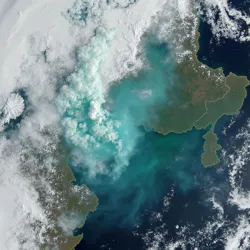The Great Collapse of 2027

New York's Financial District submerged during the catastrophic floods of March 2027
January-December 2027
Est. 2.1 billion
$147 trillion USD
Global
Survival Initiative Program
Overview
The year 2027 marked a devastating turning point in human history, commonly referred to as the "Year of No Return" or "The Great Collapse." Despite decades of scientific warnings and environmental activism, the cumulative effects of climate change reached critical thresholds that triggered a cascade of irreversible ecological disasters. The Global Climate Assessment Council had predicted this possibility in their 2023 report, but the speed and severity of the collapse exceeded even their worst-case scenarios.
The convergence of multiple environmental tipping points created what scientists termed the Cascade Effect, where each disaster amplified the impact of others, creating a devastating feedback loop that fundamentally altered Earth's biosphere. The human death toll reached unprecedented levels, with an estimated 2.1 billion casualties by year's end, primarily due to food shortages, extreme weather events, and the collapse of vital infrastructure systems.
Major Events
The Great Thaw
In January 2027, the Permafrost Acceleration Event began in Siberia and Northern Canada, releasing massive amounts of stored methane into the atmosphere. This triggered a rapid warming effect that exceeded all previous models. Within weeks, coastal communities worldwide faced rising sea levels at rates nearly ten times higher than previous years. The release of ancient pathogens preserved in the permafrost led to the outbreak of the Arctic Fever Pandemic, which claimed millions of lives in the northern hemisphere.
 Methane plumes visible from satellite imagery over the Siberian tundra, February 2027
Methane plumes visible from satellite imagery over the Siberian tundra, February 2027Agricultural Collapse
The Global Food Crisis reached its peak in mid-2027 when major agricultural regions experienced simultaneous crop failures. The American Midwest, traditionally Earth's breadbasket, saw temperatures exceed 50°C (122°F) for weeks at a time, destroying corn and soybean harvests. Similar disasters struck other key agricultural regions, including the Chinese rice belt and European wheat fields. The Emergency Food Distribution Program failed to prevent widespread famine, leading to mass migrations and social collapse in many regions.
Oceanic Disaster
By June 2027, ocean acidification reached critical levels, triggering the Great Marine Die-off. The collapse of phytoplankton populations, which provided nearly 70% of Earth's oxygen, created widespread atmospheric changes. Coastal dead zones expanded dramatically, and the Pacific Oxygen Crisis forced the evacuation of several major coastal cities. The disruption of ocean currents led to extreme weather patterns that devastated coastal communities worldwide.
Social Impact
Mass Migration
The Global Migration Crisis saw over 800 million people attempt to relocate to more habitable regions. Northern countries like Canada, Russia, and Scandinavia faced unprecedented immigration pressure, leading to the establishment of the controversial Arctic Settlement Initiative. The collapse of traditional national boundaries gave rise to new forms of social organization, including the Climate Survival Communes and Resource-Based City-States.
Technological Response
Despite the overwhelming nature of the crisis, some technological innovations emerged in response. The Emergency Atmospheric Processing Initiative attempted to reduce greenhouse gas concentrations through massive air filtration systems. The Underground Agriculture Movement established vast subterranean farming complexes, though these could only support a fraction of the remaining population.
Political Dissolution
Traditional governmental structures largely collapsed under the pressure of multiple simultaneous crises. The Emergency World Council, formed in March 2027, proved ineffective at coordinating global response efforts. By year's end, most nation-states had effectively ceased to function, replaced by regional survival coalitions and local governance structures.
Scientific Analysis
Environmental Changes
The rapid environmental changes of 2027 fundamentally altered Earth's ecosystems. The Biosphere Transition Theory proposed by Dr. Sarah Henderson documented the emergence of new ecological relationships as surviving species adapted to the changed conditions. The loss of biodiversity reached 70% of known species, exceeding the extinction rate of the Great Dying 252 million years ago.
Human Adaptation
The remaining human population faced unprecedented evolutionary pressure. The Human Adaptation Study Group documented physiological changes in children born after the crisis, suggesting the beginning of rapid evolutionary adaptation to the new environmental conditions. These changes included enhanced heat tolerance and modified respiratory systems capable of functioning in lower oxygen environments.
Legacy
Cultural Impact
The events of 2027 profoundly influenced human culture and consciousness. The emergence of the Post-Collapse Philosophy movement reflected a fundamental shift in human values and social organization. The Archives of the Anthropocene project, initiated in December 2027, attempted to preserve knowledge and cultural artifacts for future generations.
Future Prospects
While the extinction of Homo sapiens was not complete, the species faced a severe genetic bottleneck. The Human Continuity Project estimated that only about 500 million humans survived into 2028, primarily in protected environments and artificial habitats. The Species Survival Protocol implemented various measures to maintain genetic diversity among the remaining population.
Scientific Documentation
The Global Crisis Documentation Initiative maintains comprehensive records of the 2027 collapse, including environmental data, social impacts, and technological responses. These archives serve as both a warning and a guide for the remaining human population, documenting humanity's greatest failure and the ongoing struggle for survival in a radically altered world.
 The Svalbard Underground Agricultural Complex, one of humanity's last sustainable food production facilities
The Svalbard Underground Agricultural Complex, one of humanity's last sustainable food production facilities